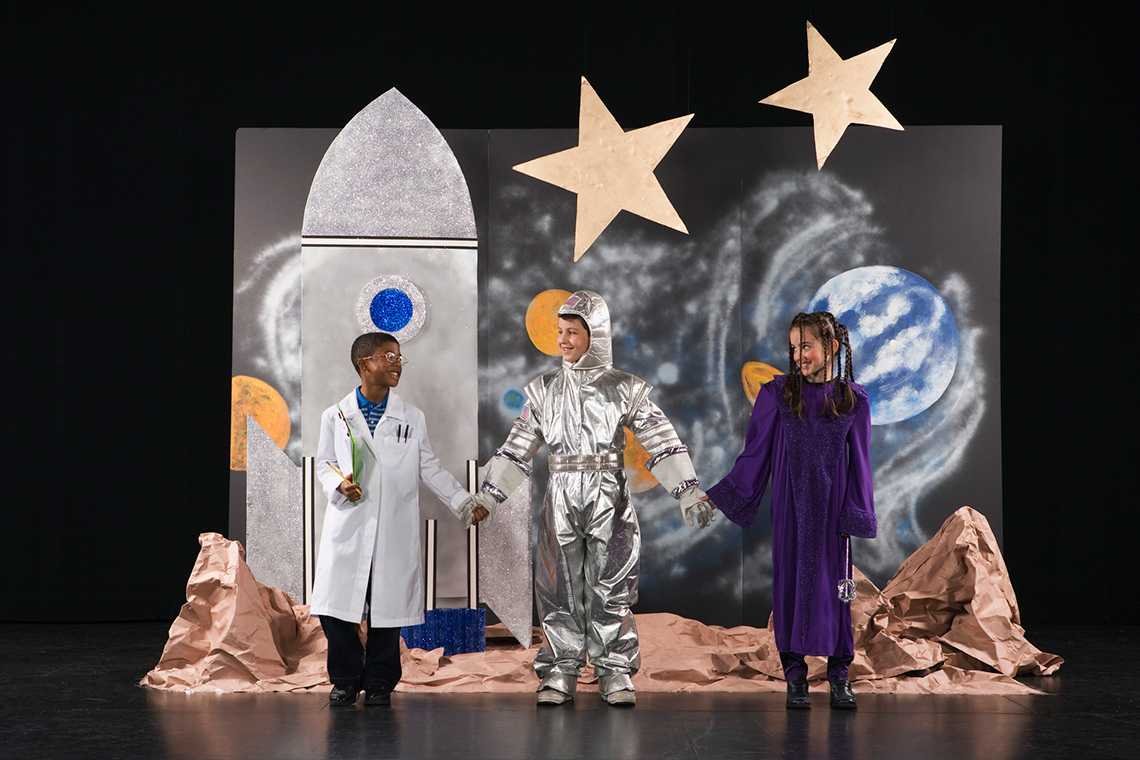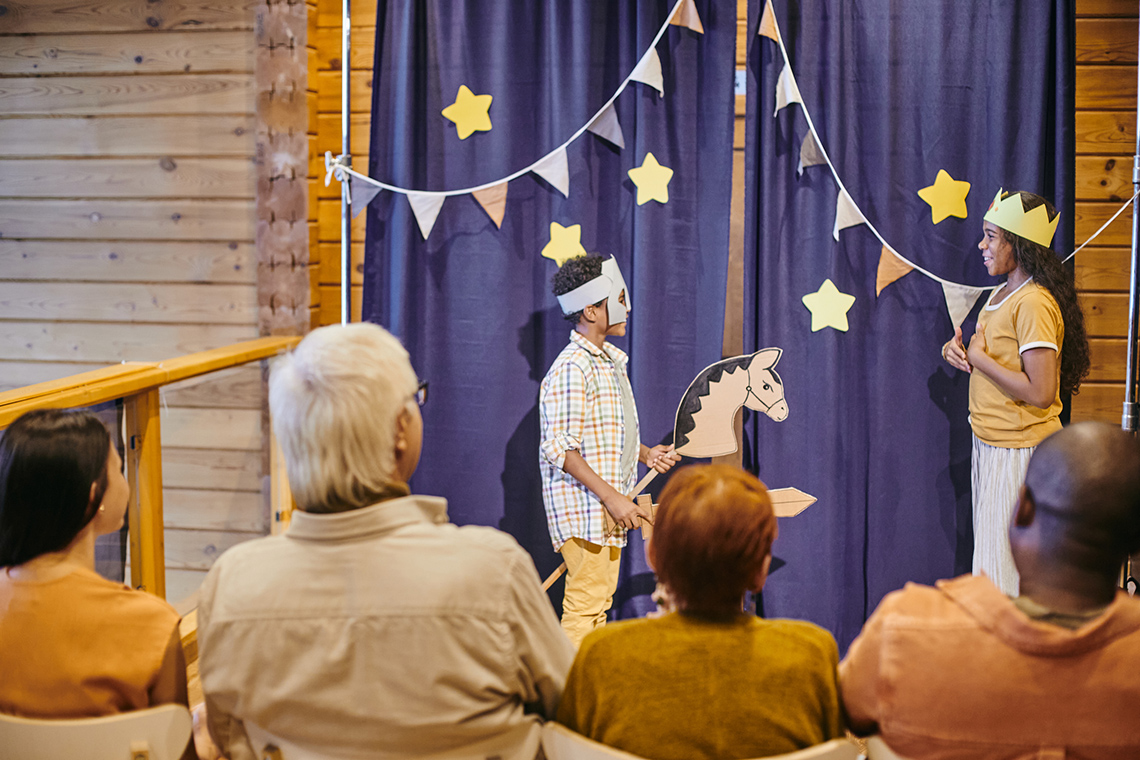Minds On
Warm up

Don’t forget to do your safety check!
Warm Up
Breathing activity
Find a comfortable position. Focus your attention on one part of the body at a time.
How does that part of your body feel? If possible, take a deep breath and allow your lungs to expand.
Focus your attention on one part of your body. Allow that part to relax before moving on to the next. As you scan through your body, keep breathing deeply.
Once you have completed the scan, take a moment to stretch.
Explore this audio recording entitled “Breathing Activity” to learn more about completing this warm-up exercise.
Breathing Activity
Drama game

Let’s create something new out of everyday objects.
Select three objects (such as a chair, a scarf, or a book), and imagine that they are something else entirely.
For example, a book might become a bird with its wings flapping. Use your imagination!
Using your three objects, create a short drama story.
Let’s get started
“The Lion and the Mouse”

Explore the following story. Only part of it has been provided.
A Lion lay asleep in the forest, his great head resting on his paws. A timid little Mouse came upon him unexpectedly, and in her fright and haste to get away, ran across the Lion's nose. Roused from his nap, the Lion laid his huge paw angrily on the tiny creature to kill her.
"Spare me!" begged the poor Mouse. "Please let me go and some day I will surely repay you."
The Lion was much amused to think that a Mouse could ever help him. But he was generous and finally let the Mouse go.
Some days later, while stalking his prey in the forest, the Lion was caught in the toils of a leftover fishing net. Unable to free himself, he filled the forest with his angry roaring. The Mouse happened to be nearby and heard the Lion…
Pause and Reflect
What happens next?
What would you do next if you were playing one of the characters? What do you think should happen next?
Record your ideas using a method of your choice. Consider adding your work to your drama portfolio.
Action
Get ready, get set…

Process drama versus formal theatre
Process drama is a type of theatre that is unplanned. One type of process drama includes roleplay. There is no set story when you are roleplaying. The actor gets to decide what happens.
Parts of a process drama
Process drama/roleplay has many unique features:
- It doesn’t have a script.
- It doesn’t have scenery or costumes.
- It doesn’t involve a crew. There is no need for lighting or costume designers.
- It is unplanned. Props are used without thinking ahead of time about how they will be used.
- There is no set story, only a prompt or a beginning of a story.
An example of process drama is when you are given a prompt or scenario that you have to act out. With process drama, you aren’t given much time to review that scenario. Instead, it’s about being in the moment and making decisions as you act.
Another important part of process drama is stopping what you are doing and analyzing the scenario out of role.
Press ‘Definition’ to learn more about what “out of role” means.
"Out of role" means you aren’t acting at that moment. Instead, you are thinking about how to play your role.
Going out of role is a good way to stop and decide what you think is going to happen next or what your character should do.
Here’s an example of being out of role, where an actor has been given the following scenario:
One person is sound asleep in their bed. They wake up suddenly and look at the clock. They are late for school. They scramble to get ready and…
They might act this out, and then when they get out of role, decide what might happen next.
Maybe the character gets ready and manages to catch the bus in time. Maybe they have to run after the bus, and they don’t catch it. It’s up to the actor to decide.
Formal theatre

Formal theatre is a type of drama that is usually held in a theatre space. Any time a person goes to a play or a musical, that’s formal theatre.
Parts of formal theatre
Formal theatre might include:
- a script
- a director who provides guidance
- actors who follow instructions from the director
- scenery and costumes
- a theatre crew (e.g., sound designer, lighting designer, costume designer, etc.)
Formal theatre is planned, which means that even things like props are organized ahead of time.
There is also a story written by a playwright and developed by the director.
Press the following tabs to learn more about a director’s responsibilities in formal theatre.
A director is someone who is in charge of the creative vision of a production. Creative vision includes what the production will be, how it will be portrayed, how the actors should perform, and most importantly, what the audience should hopefully feel as they are enjoying the play.
One way to think about creative vision is to imagine what the play would be like.
Explore the following script page as an example of formal theatre. The scene is laid out in the middle of the page and there are notes surrounding it when you use a script format. There is also dialogue and directions for the actors.

A page from a script for a play. The script indicates the setting, characters and dialogue. Act one. Scene one. At rise: Lights brighten on the interior of Dr. Jameson’s office. David sits reading the latest copy of Time magazine. He turns a page, sighs, turns another, sighs again and finally throws the magazine to the coffee table. He stands and begins pacing the room. Dr. Jameson enters and extends an open hand to David. Dr. Jameson (speaking): “David? I’m Dr. Jameson. Sorry about the wait. Fridays are always a crunch day for me. Tommy many people in too short of time”. David (speaking): “So business is really booming, huh?”. Dr. Jameson (speaking): “I guess you could look at it that way”. Dr. Jameson walks towards his office door and motions David inside. The script contains annotated notes along the margins of the page to explain the features of the script. “The Act and Scene citation usually is centered on the first page of dialogue; some writers put it all the way to the left of the margin. An alternative to this to note the act, scene and page number in the upper right-hand corner, numerically. Act One, Scene One, Page One would read I-1-1, or Act Two, Scene One, Page 4 would read II-1-4”. This note refers to the Act One, Scene 1 at the top of the page. “Number your pages” is a note at the top of the page next to the number 1. “Some writers capitalize the name of the character when he/she first appears”. This note refers to the first mention of Dr. Jameson in the script. “An alternative to this is to note TIME and PLACE”. This note refers to the term AT RISE at the beginning of the scene. “These are only the directions we need to know to start the scene i.e. what’s going on at the beginning of the play”. This note refers to the stage directions at the beginning of the scene. The character’s name is in all caps and centered. This note is referring to the character DR JAMESON. “Dialogue stretches from margin to margin. It is single spaced, or a space and a half, with a double space between two characters speaking”. This note is added in the margin next to a line of dialogue from Dr. Jameson. “These internal stage directions, or action, can appear here, or justified right and italicized”. This note is added in the margin next to the italicized direction “Dr Jameson walks towards his office door and motions David inside.”
True or false?
Let’s review what you’ve learned so far about process drama and formal theatre!
Select the correct answer, then press ‘Check Answer’ to see how you did.
Go!

Let’s compare process drama to formal theatre.
Review the following process drama prompts. You may use the following drama conventions to explore your process drama prompt. You can also record your ideas as a detailed written or audio clip about what you would do for each scenario. Consider adding your work to your drama portfolio.
Press the following tabs to access each drama convention.
A tableau is a silent, motionless picture. In drama, we can use tableaux to express different themes, feelings, and ideas. Tableaux may be presented as stand-alone images to communicate one specific message or may be used in a longer dramatic work.
Explore this video entitled “What is a Tableau?” to learn about the four different features of a tableau. The four features are stillness, facial expressions, filling the space, and levels.
A monologue is a long speech by one character in a drama. It is meant for the character to share their thoughts and feelings with the audience.
Explore this video entitled “Monologue” to learn more about how actors use monologues to communicate their ideas and emotions to the audience.
Narration is a convention where the speaker describes the action that is happening in a drama story or play. Narration can be used to describe the action through a third-person narrator that is not a character in the drama story or play.
Access this example of a narration audio clip from “The Wasps, the Bees and the Hornet.”
The Wasps, the Bees and the Hornet
Process drama prompts
If possible, as you examine each of the following drama prompts, act them out. Feel free to pause halfway through and come out of role to decide how you think your character should act and what should happen next.
Press the following tabs to access each drama prompt.
What’s the weather outside right now? Describe the weather.
Next, imagine that all of sudden the weather changes completely.
This change can be as imaginative as you like. For example, the sky could open up and start raining candy canes. Describe the change and create a narration of the whole scene.
Imagine you are able to interview someone, real or fictional. What kinds of questions would you like to ask them? Create a list and practise your interview questions.
Next, think about how they might respond to your questions.
Performing a scene

Explore the following character bios and script page for “The Lion and the Mouse.” Take your time to go through all the details including the stage directions.
Use the following checklist to guide you through this activity.
“The Lion and the Mouse”
Press the following tabs to access the character bios, script page, and the director’s instructions and vision.
Lion:
- big
- proud
- sleepy
- thinks they are more important than others
Mouse:
- kind
- sweet
- nervous
ACT ONE
Scene 1
AT RISE: Lights brighten on interior of a forest. LION is on the ground, sound asleep, his head resting on his paws. MOUSE enters and squeaks.
MOUSE
(whispering)
Oh! Oh no! A lion! I had better be careful.
Mouse runs away from Lion but in their haste, runs across Lion’s nose, waking them up.
LION
(yawning)
What? What’s this? Ah ha! I got you!
Lion lays his huge paw on the tiny mouse.
MOUSE
(frightened)
Spare me! Please, please let me go. One day I will repay you.
Lion laughs loudly.
LION
You? Repay me? I’m not sure you will ever do that. But we shall see. I will let you go.
MOUSE
Oh, thank you! Thank you!
Mouse scurries off. Lion yawns and falls asleep again
ACT ONE
Scene 2
AT RISE: Lights brighten on interior of a forest. LION is stalking his prey when they get caught in a net.
LION
What? No! I can’t escape. What will I do?
Lion roars loudly in anger and frustration. Mouse appears on the other side of the stage.
MOUSE
What is that mighty roaring? It sounds as if it’s LION. Maybe he’s in trouble.
Mouse rushes quickly to Lion.
MOUSE
(seeing Lion in a net)
Oh no! You are trapped in the net. Don’t worry, I will save you.
LION
(moaning)
How can you save me? You are too small. I will be stuck here forever.
MOUSE
Don’t be silly. Just give me a moment.
Mouse begins to gnaw at the ropes. She bites at the ropes until Lion is free and able to escape from the net.
LION
You did it! I’m free.
Lion roars in relief.
MOUSE
You laughed when I said I would repay you. Now you see that even a Mouse can help a Lion. Remember, a kindness is never wasted.
Explore this audio recording to learn more about the director’s instructions for each of the characters.
"The Lion and the Mouse": Director’s Instructions
Access this audio recording to learn more about the director’s vision of the play.
"The Lion and the Mouse": Director’s Vision
Consolidation
Putting it all together

Reflect on your experience with process drama and formal theatre using the following questions:
- Now that you have tried both process drama and formal theatre, which experience did you enjoy. Why?
- How might having a script help an actor create a character? How might process drama help an actor create a character?
Complete the Reflection Journal in your notebook or using the following fillable and printable document. If you would like, you can use speech-to-text or audio recording tools to record your thoughts. Consider adding your work to your drama portfolio.
|
Between process drama and formal theatre, which experience did you enjoy? Why? |
|
How might having a script help an actor create a character? |
|
How might process drama help an actor create a character? |
|
Which drama conventions would you use in future drama work? Why? |
Press the ‘Activity’ button to access the Reflection Journal.
Portfolio
Review your learning
Reflect on the following questions and record your thoughts using a method of your choice. Consider adding your ideas to your drama portfolio.
- What did it feel like to perform each type of drama?
- What have you learned about process drama and formal drama?
Reflection
As you read through these descriptions, which sentence best describes how you are feeling about your understanding of this learning activity? Press the button that is beside this sentence.
I feel...
Now, record your ideas using a voice recorder, speech-to-text, or writing tool.